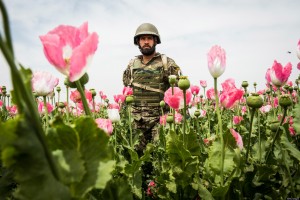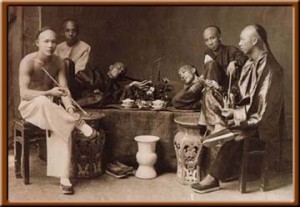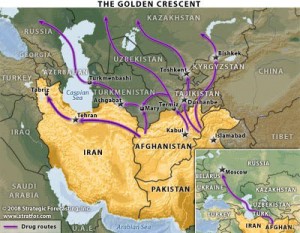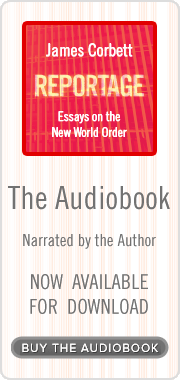 by James Corbett
by James Corbett
TheInternationalForecaster.com
May 6, 2015
Great news for poppy farmers in Afghanistan: a mysterious, brand new strain of poppy seed has appeared on the scene this year promising a better crop than ever before. According to farmers in poppy-rich Helmand and Kandahar provinces, the seeds appeared out of nowhere, delivered to them by the same drug traffickers who provide them with tools, fertilizer, farming advice and cash advances at the start of each growing season and come back to collect the crop at the end of each season. As Gul Mohammad Shukran, head of Kandahar’s anti-narcotics department, explains, this new strain of seed is expected to produce “better drug plants, which require less water and have a faster growth time.”
It goes without saying that this news is even better for the mysterious seed-suppliers who end up taking the harvested opium and transporting it off to foreign countries to be processed into heroin and sold on the black market. But it works out best of all for the treaty organization that invaded the country 14 years ago and has overseen record bumper poppy harvest after record bumper poppy harvest year after year after year after year after year ever since.
That the NATO forces in Afghanistan are protecting the poppy crop is not even a point of controversy. Five years ago Lt. Colonel Brian Christmas of the U.S. Marines went on Fox News to lament that it “may grind in his gut,” but the NATO troops just have to help the farmers cultivate the poppy crop otherwise the farmers would turn against them.
And just like that, the entire “war on drugs” is exposed for the lie that we already knew that it was. Afghanistan produces 90% of the world’s opium from which heroin is derived. The poppies from which that opium is collected are protected by U.S. marines and others in the full knowledge that this will end up on the streets of countries around the world as heroin.
Why this is the case isn’t hard to understand. The first and easiest explanation is the one that makes the world go round: Money, Money, Money! The sale of heroin is a $55 billion a year trade even by official UN estimates. Controlling the poppy fields of Afghanistan, therefore, is a military operation that pays for itself for any occupier unscrupulous enough to protect the drug trade.
But far beyond protecting the drug trade, NATO forces have long been implicated in shipping the drugs out of the country and helping bring them to the world market.
This explains the NATO helicopter that broke drug runner/assassin/terrorist/Gladio operative Abdullah Catli out of his Swiss prison cell in 1990.
This explains why the DEA was explicitly told to back off its investigations of former Afghan President Hamid Karzai’s drug-dealing brother by both the White House and the CIA.
This also explains why opium cultivation has tripled in Afghanistan since 2002 and why the State Department refuses to state for the record that poppy eradication was ever part of the US’ goal in the country.

In the 20th century a remarkably similar strategy was employed by the US in their proxy war with the Soviets during the Afghan-Soviet War of 1979-1989. As was asserted at the time by veteran researchers like Alfred “The Politics of Heroin in Southeast Asia” McCoy and finally admitted by the Washington Post in May 1990, the CIA and their Pakistani cohorts had deliberately protected Gulbuddin Hekmatyar and other “Afghan freedom fighters” despite the fact (or, more likely, because of it) that they were the country’s main heroin manufacturers. This not only led to a situation where more than 60% of heroin in the US itself was being directly supplied by a CIA operation, but also to encourage use and addiction of opiates by Soviet troops. The tactic was remarkably successful; not only did Russian troops bring their heroin addictions back home after the war, the explosion of opium in the past two decades has flooded Central Asia and Russia with enough raw material to fuel that addiction. In 2009 Russia’s own drug agency admitted the country was now the world’s number 1 consumer of heroin.

Despite this, business continues as usual for NATO in Afghanistan, especially now that Obama has announced (to absolutely no one’s surprise) that US troops won’t be withdrawn this year as originally planned. Drone strikes will continue to kill “militants” in Afghanistan on a regular basis. Foundation-funded “investigative news sites” will continue to “break stories” about a handful of soldiers involved in millions of dollars worth of fraud. Meanwhile the Pentagon will continue to hemorrhage unaccounted for trillions and facilitate a multibillion dollar drug trade without a peep from any crusading investigative reporter on a foundation payroll.
Oh, and the “mysterious sources” that are providing these new poppy seeds to the Afghan farmer? Don’t worry about it. I’m sure someone is going to make a killing on it.








For anyone who was wondering I’ve been sick in bed and thus not able to produce much for the website in the last few days. Don’t worry, though, I’m working on a very informative podcastumentary that should be dropping in the next few days. Stay tuned…
At the tender age of 19, my first employer was a crusty old guy with a small business. He would tell me how most so-called “respectable” institutions, especially governments, were dens of murderous thieves who couldn’t be trusted with a baby’s candy.
I thought he was just trying to play a head game on me because I was a kid. Didn’t take him seriously at all. Now, over forty years later, I’ve become him.
Get well soon James, you’re needed.
“a mysterious, brand new strain of poppy seed has appeared on the scene this year promising a better crop than ever before.”
You don’t think Monsanto has anything to do with this new seed? Just a thought.
Let’s be honest: we ALL thought of Monsanto/Dupont/Syngenta/BASF (by way of NATO (by way of opium trader middlemen)), right?
ALLEGATIONS OF OPIUM SMUGGLING ON NATO’S KANDAHAR AIRFIELD SURFACE (YET AGAIN).
http://www.straight.com/news/afghanistans-kandahar-airfield-alleged-heroin-hotbed
Fuel for the fire.
South Carolina Businesses Laundering Billions in Heroin Money
http://www.wmbfnews.com/story/29046749/south-carolina-businesses-used-to-launder-billions-to-drug-cartels-terrorists
“…the only state in the union where you can find every strain of heroin produced on the planet.”
Want to Hurt the Taliban? Legalize Opium in Afghanistan
http://www.defenseone.com/ideas/2016/12/want-undermine-taliban-legalize-opium-afghanistan/133778/
The US government has spent some $12 billion in eradication efforts—more than four times the size of the entire pre-invasion economy. Yet, Afghanistan now supplies around 90% of the world’s opium.
Spot the anomaly in this chart:
https://twitter.com/EMCDDA/status/806068212722962432
DEA: Heroin Haul Largest Ever in Afghanistan, ‘if Not the World’
http://abcnews.go.com/International/dea-heroin-haul-largest-afghanistan-world/story?id=44216333
“If that was Pablo Escobar’s stash, that would be considered a lot of frickin’ heroin,” said one combat veteran of the DEA’s 11-year counternarcotics mission to blunt the country’s heroin trade, referring to the Medellin, Colombia, narcotics kingpin killed two decades ago. “That’s going to make a dent in the European market.”
If 20 tons fell, 40 went through. That’s what people who are close to this business tell, anyway.